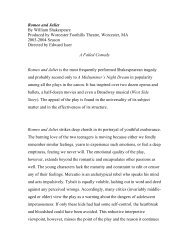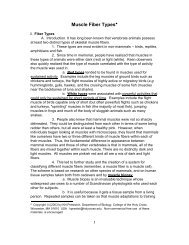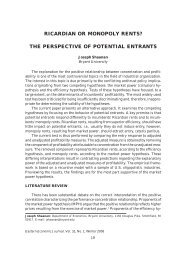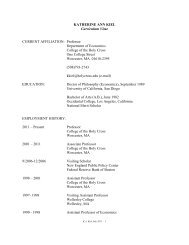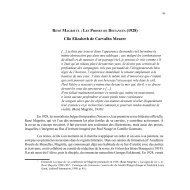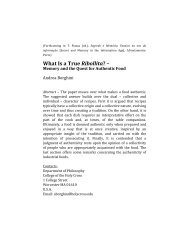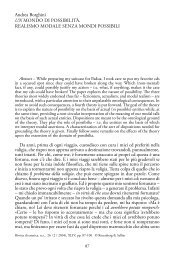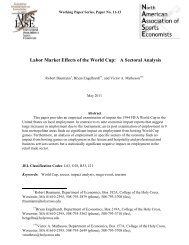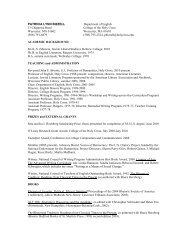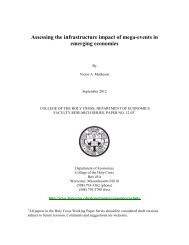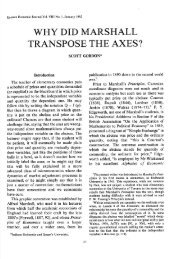29-2 Singh.pmd - College of the Holy Cross
29-2 Singh.pmd - College of the Holy Cross
29-2 Singh.pmd - College of the Holy Cross
Create successful ePaper yourself
Turn your PDF publications into a flip-book with our unique Google optimized e-Paper software.
CAPITAL ACCOUNT LIBERALIZATION<br />
193<br />
These issues <strong>of</strong> capital account liberalization are, <strong>of</strong> course, not only <strong>of</strong> academic<br />
interest, but clearly <strong>of</strong> serious policy concern for developing countries. Note that <strong>the</strong><br />
present paper concentrates exclusively on <strong>the</strong> international dimension <strong>of</strong> <strong>the</strong> policy<br />
debate on <strong>the</strong> subject. Orderly and fast progress toward capital account liberalization<br />
for all countries has been at <strong>the</strong> heart <strong>of</strong> <strong>the</strong> proposals by G7 countries for <strong>the</strong><br />
New International Financial Architecture (NIFA). Similarly, <strong>the</strong> European Union<br />
and Japan have raised <strong>the</strong> question <strong>of</strong> <strong>the</strong> free movements <strong>of</strong> FDI as an important<br />
subject for study and eventual negotiations at <strong>the</strong> WTO. Unlike <strong>the</strong> aborted OECD<br />
Multilateral Agreement on Investment, <strong>the</strong>se new proposals wholly exclude shortterm<br />
capital flows and focus entirely on FDI. To date, <strong>the</strong>se proposals have received<br />
little academic or public attention. Now, following <strong>the</strong> Doha WTO Ministerial Declaration,<br />
<strong>the</strong>se issues are on <strong>the</strong> international agenda and merit urgent scrutiny. There<br />
is already a large literature on <strong>the</strong> NIFA. 1 However, <strong>the</strong> advanced countries’ proposal<br />
for <strong>the</strong> free movement <strong>of</strong> FDI has not been studied much. The second half <strong>of</strong> <strong>the</strong><br />
paper redresses this imbalance by focusing on FDI flows, specifically on <strong>the</strong> proposed<br />
new multilateral agreement on such flows.<br />
To sum up, <strong>the</strong> main contribution <strong>of</strong> this paper lies firstly in bringing toge<strong>the</strong>r<br />
<strong>the</strong> relevant <strong>the</strong>ory and empirical evidence from diverse areas (<strong>the</strong>ory <strong>of</strong> international<br />
trade, <strong>of</strong> international factor movements, <strong>of</strong> industrial organization, <strong>of</strong> finance,<br />
and <strong>of</strong> economic development) to bear on important international economic policy<br />
issues with respect to both short-term and long-term capital flows to developing countries.<br />
Secondly, <strong>the</strong> paper examines <strong>the</strong>se multilateral arrangements entirely from a<br />
developing country perspective. Thirdly, it provides analysis and evidence to suggest<br />
that even unfettered FDI, a capital inflow favored by most economists, may not serve<br />
<strong>the</strong> developmental needs <strong>of</strong> many countries. Fourthly, <strong>the</strong> paper provides a critical<br />
analysis <strong>of</strong> <strong>the</strong> proposed new multilateral agreement (PMAI) being put forward at<br />
<strong>the</strong> WTO by some advanced countries. As mentioned above, very little work has been<br />
done on this specific topic before.<br />
FREE TRADE VERSUS FREE CAPITAL MOVEMENTS: ARE THEY<br />
ANALOGOUS? 2<br />
Free Trade and Economic Openness: Analytical Considerations<br />
The traditional case for free trade can best be put in terms <strong>of</strong> <strong>the</strong> two fundamental<br />
<strong>the</strong>orems <strong>of</strong> welfare economics. According to <strong>the</strong> first welfare <strong>the</strong>orem, a competitive<br />
equilibrium in <strong>the</strong> absence <strong>of</strong> externalities and non-satiation constitutes a Pareto<br />
optimum. The second <strong>the</strong>orem, which is more relevant for present purposes, states<br />
that any Pareto optimum can be realized as a competitive equilibrium in <strong>the</strong> presence<br />
<strong>of</strong> all-around convexity, provided suitable lump-sum transfers can be arranged<br />
among <strong>the</strong> participants. Most <strong>of</strong> <strong>the</strong>se assumptions are erroneous or are not easily<br />
met in <strong>the</strong> real world. Never<strong>the</strong>less, neoclassical economists suggest that such considerations<br />
do not destroy <strong>the</strong> case for free trade; <strong>the</strong>y only change <strong>the</strong> nature <strong>of</strong> <strong>the</strong><br />
argument. Thus, Krugman concludes his classic defense <strong>of</strong> free trade in terms <strong>of</strong><br />
modern <strong>the</strong>ory as follows: “this is not <strong>the</strong> argument that free trade is optimal because



